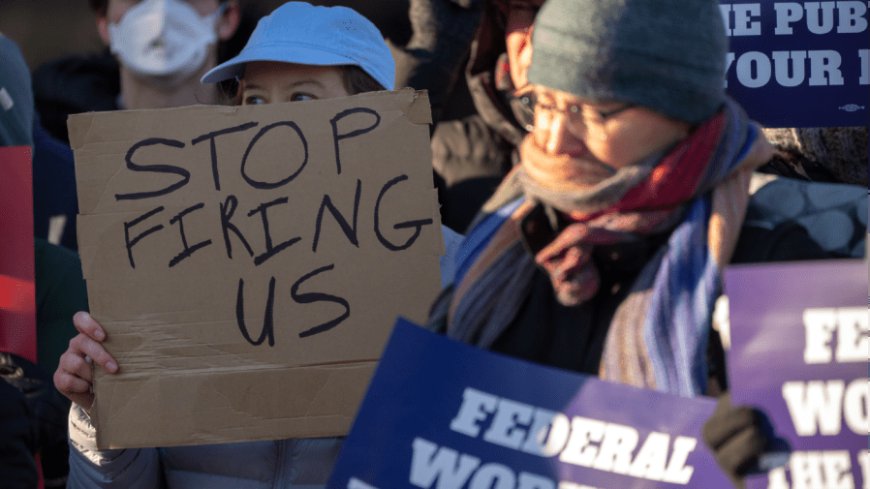Federal employees bracing after Supreme Court greenlights widespread layoffs
A Supreme Court decision giving the Trump administration the greenlight to lay off tens of thousands of employees threatens to reshape the federal workforce amid a broader battle over whether the president has the power to do so. The Tuesday decision was the latest example of the court stepping in to stop a nationwide injunction...

A Supreme Court decision giving the Trump administration the greenlight to lay off tens of thousands of employees threatens to reshape the federal workforce amid a broader battle over whether the president has the power to do so.
The Tuesday decision was the latest example of the court stepping in to stop a nationwide injunction – leaving President Trump free to conduct widespread layoffs even as the legal tussle continues.
While a patchwork of other injunctions leaves a few limited protections in place, employees at some 17 agencies impacted by the ruling are bracing for what President Trump in February called “a critical transformation of the Federal bureaucracy.”
BestReviews is reader-supported and may earn an affiliate commission.
Amazon Prime Day Deals

The Trump administration was on the precipice of carrying out layoffs when the courts blocked the plan in May – agencies had been asked to submit their plans for Reductions in Force (RIFs) by April and were just waiting for administration approval.
Some agencies have already said they plan to take swift action in the wake of the decision.
“The Supreme Court decision has allowed us to commence, and that’s what we’re doing,” State Department spokeswoman Tammy Bruce told reporters Thursday.
“It will happen quickly. This is not going to be an extended wait for people who are listening and watching in this building or fellow Americans at home and around the world. This will happen quickly. We understand that there has been a delay, not to our interests but because of the courts.”
On Friday, the department said it would lay off more than 1,300 employees, including 1,107 civil servants and 246 foreign service officers who currently have domestic assignments in the United States.
And others among the 17 agencies have already given signals as to the extent of their planned cuts. Health and Human Services, which already announced plans to cut 10,000 employees of the 82,000 on payroll at the start of the administration.
Agencies like the Environmental Protection Agency, the Social Security Agency, Veterans Affairs and more are impacted by the ruling.
The American Federation of Government Employees (AFGE), the largest federal government union, described the news as devastating for government services as it is for employees’ careers.
“There is a lot of legitimate concern among our members not just for their own jobs, but for the Americans who rely on the services they provide — from small businesses, veterans, and Social Security recipients to everyday American consumers,” AFGE president Everett Kelley
“It’s a life-altering decision for tens of thousands of American families. Federal employees across the country will sit at their dinner tables tonight with their layoff notice next to a pile of bills, knowing the Supreme Court’s action just changed their lives forever, and they’re wondering what they’re going to do next to make ends meet. They didn’t ask for this - all they wanted to do was serve their country.”
The Supreme Court’s decision only weighed the injunction lifted by a lower court judge, not the underlying layoff authority or plans themselves.
“The content of the [Agency RIF and Reorganization Plans] thus remains squarely at issue in this case,” U.S. District Court Judge Susan Illston wrote in a Thursday order granting further discovery in the case.
The dissent from Supreme Court Justice Ketanji Brown Jackson, however, faulted her colleagues for giving the go ahead on a plan that may later be determined to be unlawful.
“That temporary, practical, harm-reducing preservation of the status quo was no match for this Court’s demonstrated enthusiasm for greenlighting this President’s legally dubious actions in an emergency posture,” she wrote.
The decision will allow “all the harmful upheaval that edict entails, while the lower courts evaluate its lawfulness. In my view, this was the wrong decision at the wrong moment, especially given what little this Court knows about what is actually happening on the ground,” she argued.
Unions too had argued there would be “no way to unscramble that egg.”
The ruling comes after the Supreme Court in a case dealing with Trump’s effort to end birthright citizenship placed limits on the extent lower courts can use nationwide injunctions - a massive win for the Trump administration amid complaints about district court judges blocking their policies.
Agencies are in many cases still waiting to hear back from the Office of Management and Budget and the Office of Personnel Management on their plans, but a joint memo from the agencies suggested speed is the goal.
Agencies were directed to seek a waiver to shorten the notification window for employees, giving workers as little as 30 days notice that they will lose their jobs, rather than the traditional 60 days.
Once those plans are revealed, the specifics could also be challeneged as well as the process for rolling them out. RIF plans in some cases can require congressional or union notification.
Lawmakers in regions with large numbers of federal employees also said they plan to be engaged on any efforts for sweeping layoffs.
“The Court’s decision to allow this damage to be done before ruling on the merits shows how detached they are from the reality of the moment,” Sen. Chris Van Hollen (D-Md.)
“Make no mistake, the Trump Administration’s plan isn’t about efficiency, it’s about rigging the government to only benefit the wealthy and powerful special interests. We are not done fighting in Congress, in the courts, and in our communities to defend the dedicated public servants who go to work on behalf of the American people day in and day out.”
The planned RIFs follow a number of other moves from Trump to shrink the scope of the federal government.
Shortly after taking office, departments across government dismissed employees still in their probationary period – a time frame that can last a year or two depending on the role and that can also be reactivated by a promotion.
That too left the government dismissing thousands of federal workers who also saw their efforts to fight their dismissal hamstrung at different turns.
A challenge at the Merit Systems Protection Board (MSPB) lost the backing of the Office of the Special Counsel (OSC) after Trump fired former President Biden’s five-year appointee to the role, Hampton Dellinger.
Dellinger backed the MSPB challenge while he was fighting his own suit to keep his job, but the OSC reversed course once courts determined he could not stay in the job amid his own legal battle.
Like with the RIFs, there are some injunctions still in place that block some of the firings, but in other cases they’ve been permitted to proceed.
Sen. Angela Alsobrooks (D-Md.) criticized the latest plans for firings as part of a broader “witch hunt.”
“I will continue to fight against this President's witch hunt targeting federal workers,” she wrote on X.
“When you attack civil servants, you attack the very people they serve – the American people.”
What's Your Reaction?
























